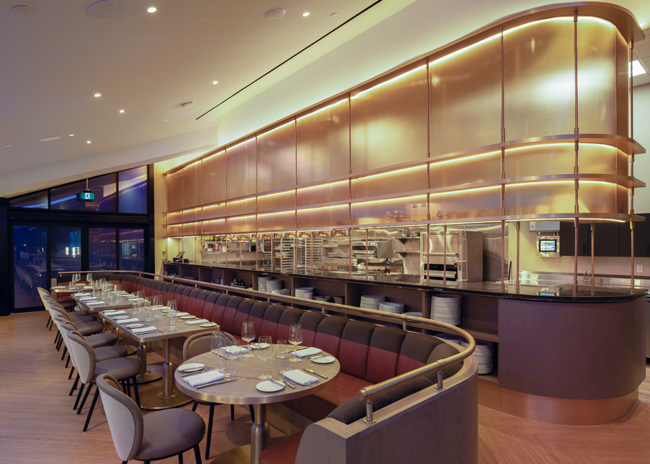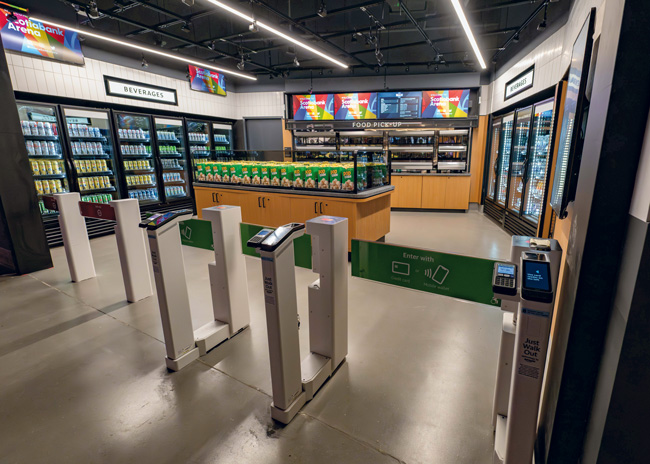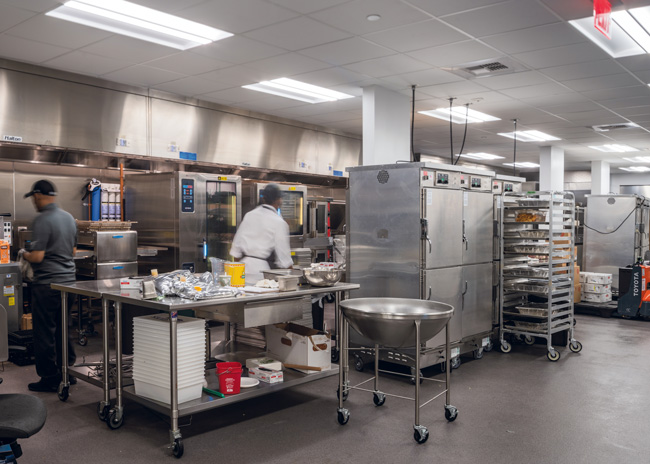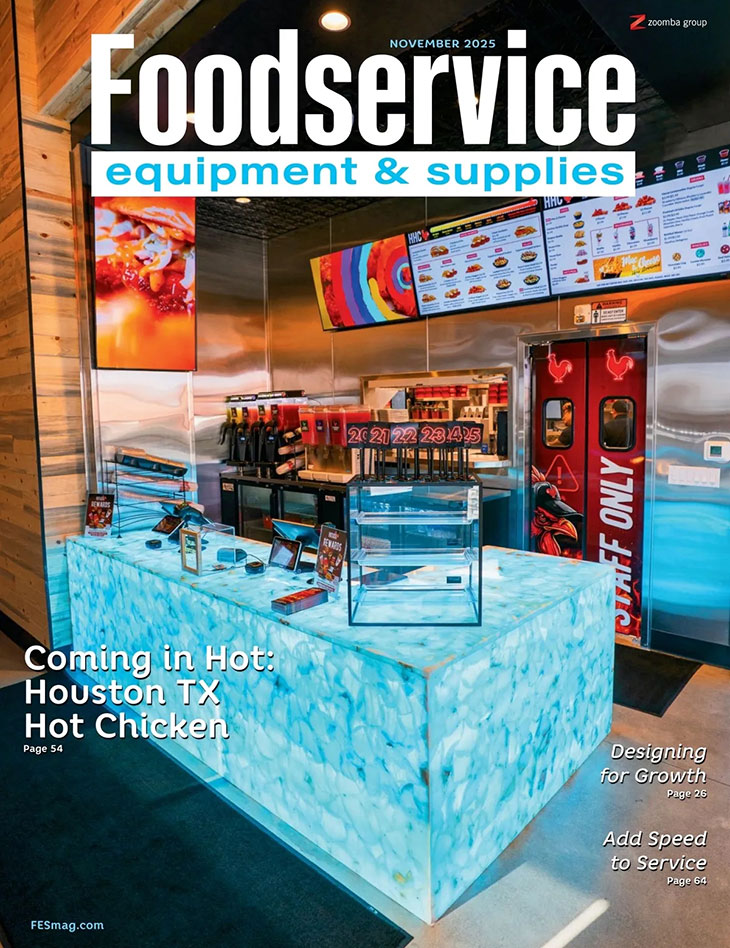Food and beverage are considered essential elements in the game-day experience. And as property and team owners seek to maximize the revenue from every square inch of a venue, they turn to their foodservice operations to deliver elevated programs that will help engage customers before, during and after the event.
The pipeline for sports venue construction is robust, according to data from Sports Business Journal, which estimated that nearly $6 billion in projects would be completed in 2024, finally reversing a multiyear, pandemic-era slump. This construction bounce encompasses facilities for professional and college teams, with renovation projects in both categories outpacing new builds.
 High-end suites and clubs are now a prime focus in sports venues, such as Scotiabank Arena in Toronto. The renovation was part of a $350 million “Reimagination” project set to finish in early 2025. Elevating the fan experience is at the heart of all decisions in a stadium or arena project — or it should be, says Matthew Anderson, associate principal, Rippe Associates. “Food offerings need to achieve a balance. There’s the value piece with staple menu items, like a hot dog, that drive sales. Those aren’t going away. But customers also crave the unique, the creative, the local and the chef-driven,” he says, adding that sports venues need to be designed around a range of desired experiences.
High-end suites and clubs are now a prime focus in sports venues, such as Scotiabank Arena in Toronto. The renovation was part of a $350 million “Reimagination” project set to finish in early 2025. Elevating the fan experience is at the heart of all decisions in a stadium or arena project — or it should be, says Matthew Anderson, associate principal, Rippe Associates. “Food offerings need to achieve a balance. There’s the value piece with staple menu items, like a hot dog, that drive sales. Those aren’t going away. But customers also crave the unique, the creative, the local and the chef-driven,” he says, adding that sports venues need to be designed around a range of desired experiences.
Today’s sports venue foodservice programs often combine the old with the new. Facilities retain many tried-and-true approaches with good reason, as they still deliver consistent results.
The Intuit Dome, which opened in 2024 as the new home of the NBA’s Los Angeles Clippers basketball team, features the Neighborwood Eats food hall that offers a rotating lineup of local restaurants serving guests during pre-event hours. Meanwhile, the facility’s 21 grab-and-go marketplaces feature crowd-pleasers like nachos and hot dogs (including “sushi dogs” — it is L.A., after all) with other less-conventional offerings like Ktown chicken & waffles (named after L.A.’s Koreatown neighborhood) and a signature butter toffee popcorn.
Sometimes, foodservice can provide a wow factor by simply upgrading fan favorites, like offering unique toppings on a hot dog, says Nick Morales, vice president foodservice design consultant, Cini-Little. Last year, Globe Life Field, home of Major League Baseball’s Texas Rangers, debuted next-gen concessions like the Ranchero Chile Relleno Dawwg. This is an all-angus beef hot dog, split and stuffed with queso Chihuahua and wrapped in roasted banana peppers and strips of bacon, all topped with grilled onions.
Foodservice is also essential to enhance fan experiences at the premium ticket levels — and these are on the rise with each build or renovation. “We’re seeing more of the elevated suites and party areas for VIP-type guests,” says Morales. These tiered amenities range from swanky VIP suites to all-you-can-eat sections with buffet service and picnic tables. They often feature many of the menu items found throughout the venue. After all, a club guest may crave the same iconic hot dog-and-beer experience as the fan in the nosebleed seats.
But the design of many of these premier areas seeks to take the guest to unprecedented levels of exclusivity. Anderson cites the Maker’s Mark Barrel Room at Wrigley Field in Chicago as one example. Everything about this private club aligns with an underground speakeasy concept. From artisan menus to crafted cocktails, the food and beverage rises to meet the premium connotations of the famous bourbon. “If foodservice doesn’t support the concept, it diminishes the entire experience,” cautions Anderson.
Food Prep
When it comes to producing the wide array of flavor experiences found throughout today’s sports venues, the commissary kitchen isn’t going anywhere, say most of the foodservice designers interviewed here. But designers are trying to give that central production facility greater support with the addition of strategically placed remote and finishing kitchens, especially near clubs, suites, on-site restaurant concepts and similar areas.
“It’s about finding the balance of how to use allocated spaces most efficiently, creating the necessary support for the foodservice operator and, ultimately, producing the best possible product for the fan,” says Anderson.
While sports venues explore a more expansive menu mix, operators aren’t really looking to add special equipment to make it happen. “Maybe they’ll add a pizza oven or create sushi stations at the point of service, but most food is going to come from the main kitchen,” says Ryan Rongo, FCSI, vice president of operations, S2O Consultants.
Industry experts point to versatility as another important consideration in kitchen equipment purchases for sports/concert venues. Operators must be mindful that menu needs can change nightly if the property schedules a game one day and a concert the next. Anderson advises operators query their foodservice designer and equipment dealer for suggestions. “Ask, ‘What else can my current equipment do, beyond the way I’ve already been using it?’” Meanwhile, new technology is just getting better and better, he says. “With one piece of equipment, a cook can execute four to five different menu items.”
If there’s one single type of equipment that can make or break a sports venue foodservice operation, it is hot holding equipment. In most sports venues, the commissary preps enormous amounts of food in advance, transporting it to locations throughout the building prior to the pregame and halftime rush periods. “Quality is going to suffer if you’re letting items sit for 90 minutes on a slide,” says Anderson. “Fried chicken is particularly hard to do without great holding equipment — or the ability to move that prep closer to the point of service.”
All the experts share a fundamental belief about what’s at stake when it comes to food quality. “Fans have high expectations and know what they can get outside the venue. They’re not going to settle for a poor food experience,” says Anderson.
 utonomous markets, such as this one at Scotiabank Arena in Toronto, continue to gain ground in sports venues. Photos courtesy of Maple Leaf Sports & Entertainment
utonomous markets, such as this one at Scotiabank Arena in Toronto, continue to gain ground in sports venues. Photos courtesy of Maple Leaf Sports & Entertainment
Market Service Models
The mobile order/pickup model at sports venues has faded, says Rongo. Taking its place is the self-contained, grab-and-go, fully or partially autonomous service approach, which is on the rise, the experts agree. But opinions differ on the specific marketplace approach that will dominate.
Morales sees the high-tech, fully autonomous systems as the ones to beat. Cini-Little was part of the team for Toronto’s Scotiabank Arena “Reimagination” renovation project, giving a lift to fans of the National Hockey League’s Maple Leafs and the NBA’s Raptors basketball team. Among the modernized amenities are several frictionless self-checkout and concessions that allow customers to scan a credit card or app, grab their food and drink items and exit.
After food quality, speed of service is high on the list of guest — and property owner — priorities. “No one wants fans spending 10 to 15 minutes in line away from the action,” says Morales. The autonomous service model puts a big dent in wait times, while also addressing labor constraints. “There was initial discomfort when these systems first came out,” he adds. “But as they continue to grow in prominence, customers are getting used to them — and they are also becoming more reliable.”
Anderson, on the other hand, expects limited-staff models to be the compromise, providing at least one or two employees to help guests troubleshoot problems, check IDs for alcohol purchases and so on. But other factors will affect the long-term success of even semi-autonomous markets, he cautions. “The self-checkout is a fantastic option, as long as each step in the queue is running efficiently. We’ve done studies on stadiums with autonomous checkout at existing points of sale, and some couldn’t keep up with the product throughput.” He thinks more research is necessary to fine-tune the process, exploring, for example, how the number of menu items impacts how quickly a guest makes their selection and frees up the kiosk to the next person.
Having heard too many horror stories about the consequences of system failures, Chris Bigelow, FCSI, president of The Bigelow Companies Inc., feels autonomous systems are not quite there yet. Instead, he expects greater success will be found in self-order kiosks and self-scan pay stations.
Taking a full-picture perspective of stadium foodservice, decisions about food and beverage are reflecting more direct involvement from property owners. In general, foodservice designers and consultants find this to be a trend in the right direction. Engaging the owners/operators means the fan experience will be at the center of all decisions, says Anderson. “Stadium owners know their fans, and they are ultimately packaging the whole game-day experience for the fan. You want them involved.”
In the end, foodservice should be poised to complement a fan’s No. 1 desire, says Bigelow. “When the team wins, the beer is colder, and the food tastes better.”
 Allianz Field, a soccer stadium in St. Paul, Minn., that opened in 2019, touts a mix of menu items from standard stadium fare like loaded nachos to global fare that runs from dumplings and Asian-inspired bowls (including a take on Hmong cuisine) to barbacoa tacos, elote nachos, Argentinian choripán and smoked gouda mac ’n cheese. Minneapolis-based Rippe Associates and Chicago-based S2O Consultants collaborated on the project.
Allianz Field, a soccer stadium in St. Paul, Minn., that opened in 2019, touts a mix of menu items from standard stadium fare like loaded nachos to global fare that runs from dumplings and Asian-inspired bowls (including a take on Hmong cuisine) to barbacoa tacos, elote nachos, Argentinian choripán and smoked gouda mac ’n cheese. Minneapolis-based Rippe Associates and Chicago-based S2O Consultants collaborated on the project.
Utility Players
 While central production kitchens like this one at Allianz Field, prepare and transport most food served in today’s sports venues, they are increasingly supported with strategically placed remote and finishing kitchens. Consultants weigh in on foodservice equipment that supports sports venue projects:
While central production kitchens like this one at Allianz Field, prepare and transport most food served in today’s sports venues, they are increasingly supported with strategically placed remote and finishing kitchens. Consultants weigh in on foodservice equipment that supports sports venue projects:
- Clamshell flattop griddles with programmable controls. “They aren’t new, but they are certainly underutilized,” says Matthew Anderson, Rippe Associates.
- Rapid-cook ovens that accommodate full sheet pans will drive both quality and efficiency in the stadium kitchen, says Nick Morales, Cini-Little.
- Ventless cooking equipment provides coveted flexibility and is great for remote and finishing kitchens, says Anderson. While Chris Bigelow, FCSI, Bigelow Companies Inc., appreciates the value of ventless but warns of limitations here: “Ventless fryers tend to have a smaller capacity, making them less attractive to operations that produce large quantities of fried foods.”
- Combi ovens and other units that control temperature and humidity, in various configurations from single to double stack to rolling, are critical, adds Ryan Rongo, FCSI, S2O Consultants.
- Smokers are becoming more popular, adds Rongo, as venues look to provide different types of barbecue.



